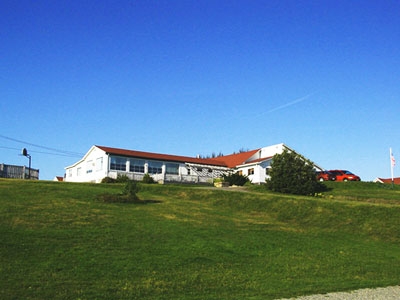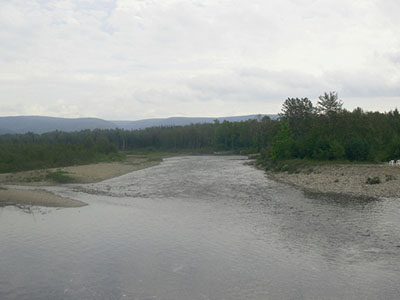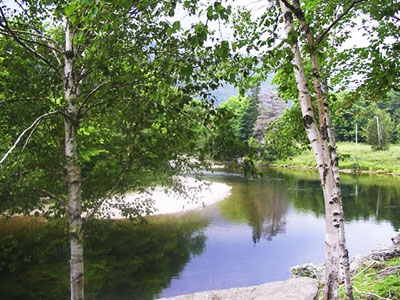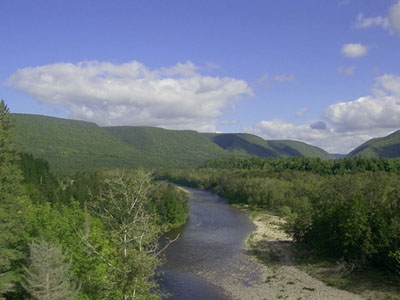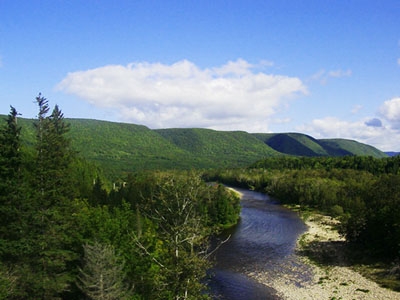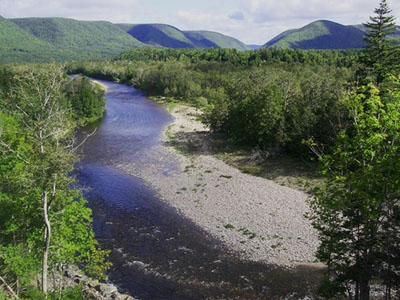
Salmon Fishing on the Magaree River
An article by Graham Anthony.
Having experienced the delights of fishing for Pacific salmon in and around Vancouver last year, I decided that this year’s adventure would be for the predictably more challenging Atlantic salmon of eastern Canada.
Looking at the map did not inspire me at all, such a vast expanse of land sea and rivers I had little idea of where to start.
Whilst scanning the eastern seaboard, whether it was Nova Scotia or unconsciously reading the name ‘Margaree forks’ but I recalled a Paul Young fishing programme of him fishing for Atlantic salmon a river called the ‘Margaree’.
Quickly I went on to the Internet and I was amazed at the amount of detailed information that was immediately available.
There is a grand old river on Cape Breton Isle that’s blessed with natures beautiful smile. From its birth in the highlands to its end in the sea it’s a wonderful river, The Margaree.
On viewing the Margaree Lodge Resort it appeared to offer all that a salmon fisherman could want and as much to satisfy my non-fishing wife.
Communication was simple, with the lodge running a professional website at www.margareelodge.com which easily translates into English, French and German.
An email to Werner the owner and I had all the advice and guidance necessary. A number of tailored fishing packages were available and at competitive prices. The salmon season on the Margaree begins June 1 and continues until October 31. You are encouraged to practice catch and release in order to perpetuate the stock of Margaree salmon for future generations. The decision was made and I booked for myself to fish and for my wife to accompany me.
The long-awaited day arrived. We had decided to travel in early September and for the week prior I was scanning the weather forecasts and was somewhat dismayed to see highs of 30 degrees with little rain. However, what slightly depressed me had my wife beaming from ear to ear.
Our scheduled 5-hour flight from Gatwick was plagued with delay but we eventually arrived at Halifax International airport and I was actually pleased to be out of the aeroplane looking forward to the 4-hour drive north.
The drive north along the Trans Canadian highways 102 and 104 through to Cape Breton, was as rugged as parts of Scotland and yet reminded me of the natural beauty of parts of the Lake District. Having passed through Truro and following signs for Inverness, at times I wondered whether I was on the road from Lands End to John o’Groats.
The wildlife was abundant with bald eagles, beaver, black bear and moose a common sight.
Having arrived at our destination, the Lodge stood on an elevated position within the valley, commanding panoramic views of the river winding its way to the ocean.
Bags unpacked, it was not long before we were striding out to a nearby bridge.
Initially, I was somewhat disappointed until I realised I was looking at the smaller of the two rivers, some 200 yards away was the confluence and hence the town name Margaree Forks.
The lodge was well set out and equipped. The restaurant was spacious and the food excellent.
I quickly learned that there are many traditions on the river with locals almost exclusively fishing with large dry flies.
During my week I was pleased to witness the local split cane society annual day.
28 anglers took to the river many utilising rods and reels that would have pleased many an antique dealer.
The locals on the river fish predominantly with dry flies tied on 4, 6 or 8’s.
All these flies were spun natural deer hair with yellow calf tail tails.
The deer hair body was palmered with a red cock hackle.
The density of the spun deer hair was the focus of much discussion, attention and admiration.
I had taken time to observe the local tactics intensely.
There were no V forming wakes utilised here, the huge dry flies (bombers) are fished very similarly to traditional trout dry flies.
Having had no luck on my traditional low water small doubles, under the watchful eye of Werner and a couple of locals I set to the task.
Favouring the locally named snag pool and remembering all the advice, shortish lines, rod held back and follow the flow, whilst all the time preparing for the take, but constantly reminding myself that when the rise occurs not to strike too quickly.
The anticipation was exciting in the extreme and you had to concentrate hard.
Within half a dozen casts my inexperience impetuous nature came to the fore.
Having identified a fresh and rising fish, easily in excess of the magical 20 lb figure I cast.
Not really confident in what I was doing or in the method I was using, but thinking of when in Rome! the inevitable happened. I was concentrating hard on the fly as it moved into and entered an eddy and suddenly from nowhere a sudden movement. a flash of silver, the surface broke, a great splash and with heart pumping, I did what I kept telling myself that I shouldn’t do!!!!! I stuck at the fish – oh no! what have I done. Too b………..y soon!
I wish I could have blamed the impetuousness on youth, but those days have passed.
One of the locals piped up ‘It’s a good job you didn’t connect, that one would have towed you halfway home. I smiled back feebly beating myself up inside. I am sure I have not been the only one in that position and am not likely to be the last.
Another of those fruitless days salmon fishing without a fish on the bank, but who cares when you can look around this location there and be reminded that I was on a beautiful river that was full of fish and the pleasant company which generated some good-hearted banter.
The low water resulted in hard fishing with little returns and the sighting of numerous fish throughout the river increased frustration. That is one of the ingredients of salmon fishing.
On the last but one night the heavens opened and the river actually rose a little over 6 inches overnight, thunder and lightening prohibited early fishing and I didn’t arrive on the river until 11 am.
There was a strong upstream wind and the locals were having difficulty controlling their casts.
The double-handed rod came into its own.
Fishing a small size 12 double, within 20 minutes I was into a fish, ten minutes later with the fish almost played out one of the locals entered the river to tail it out for its immediate release, as this fish was estimated to be approximately 18 pounds.
I was mindful not to drag and beach it for fear of causing injury and at the last moment as the fish was in approximately 9 inches of water the hook popped and away it turned back to the current.
I was exhilarated and although not officially a catch I walked away from the river with a sense of achievement.
For those of you who may be tempted, you can save some space in your tackle bag by leaving behind your trebles, they are prohibited.
Whilst the fishing on the river is free, you require a Nova Scotia licence. The visitors’ permit is only issued for 7 days and anglers are not permitted to take out two 7 day licences in any season, so if you wish to fish for longer than 7 days you will require a season licence.
With each permit, anglers are issued kill tags. The system is similar to that on Irish rivers in that these tags must be inserted into the gill covers of each killed fish immediately, and anglers are required to carry not only their permits but their issued fish tags when fishing.
To preserve fish stocks only fish under 25 inches (grilse) may be taken, all other fish must be returned.
Having fished in Sweden a few years ago I was pleased to discover that fishing ends at 10 pm and commences at 6 am.
Whilst this time restriction apparently infuriates many local anglers in the height of summer, for me it assured a good nights sleep and removed all temptation of overfishing.
At 6 am one morning whilst preparing to fish, and environmental protection vehicle drew alongside and the officer approached me.
I was somewhat taken aback by the sidearm, canister and baton attached to the belt.
There was not a hint of officiousness and he was polite in the extreme.
Helpful advice on fishing tactics and explanations of fishing pressures and catches were explained by the officer. His helpfulness and professionalism were impressive. However, his help and advice were shadowed by his lady colleague who has been equally been at home on the cover of any fashion magazine.
The river has a strict pool rotation policy which is very similar to a pace a cast with an exception that should an angler raise a fish then the angler may remain in that fixed point for three minutes.
The local and visiting anglers were extremely welcoming and helpful.
Strategically placed at each pool were benches and seats where the fat was chewed and the worldwide excuses and reasons for both failure and success were interspersed with advice and guidance.
As the main road hugs and winds along the valley bottom, there is vehicular access to within 100 yards of most pools, and a single-handed rod will suffice as the banks appear to be well maintained with little vegetation to trouble the backcast.
Double handed rods are the exception here. But bearing in mind the locals propensity to dry fly fishing perhaps it is unsurprising.
However, when the prevailing upstream wind blew I found my 14 foot double handed invaluable on the wider glides and pools.
The wading on the river was safe with a shingle bottom and few boulders, there was little need even for a wading staff.
Getting There
Booking the flights could not have been simpler. Whilst a number of carriers Halifax linked flights from Montreal or Toronto. The most convenient and most cost-effective was Zoom airlines (www.flyzoom.com) who operate direct flights from both Gatwick and Glasgow. The flight time is approximately 5 hours. The drive thereafter is approximately 4 hours but it is straightforward and pleasant. All major car hire companies operate from the airport.
If you have any questions for Graham about his trip you can contact him through the forum.


